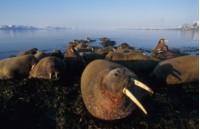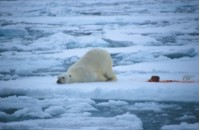|
|
Predators and top predators – the bosses and the managing director
 Walrus were once extremely common in Svalbard, but 350 years of intensive hunting almost made the population extinct. They were protected in the archipelago in 1952, when only a couple of hundred walrus were left. The numbers are still low after more than 50 years of protection, and the walrus figures on the Norwegian Red List of endangered species. The numbers have risen in recent years, and former resting places on land have begun to be used again after many decades.
Illustration: Tor Ivan Karlsen, NPI
The marine mammals, whales and seals, reign supreme in the Arctic Ltd management, along with Arctic foxes, skuas and glaucous gulls on land. These species find most of their food at the middle-management level, but may well eat one another when times are hard. The top predators have no natural enemies in their own setting.
Walrus were once extremely common in Svalbard, but 350 years of intensive hunting almost made the population extinct. They were protected in the archipelago in 1952, when only a couple of hundred walrus were left. The numbers are still low after more than 50 years of protection, and the walrus figures on the Norwegian Red List of endangered species. The numbers have risen in recent years, and former resting places on land have begun to be used again after many decades.
Illustration: Tor Ivan Karlsen, NPI
The marine mammals, whales and seals, reign supreme in the Arctic Ltd management, along with Arctic foxes, skuas and glaucous gulls on land. These species find most of their food at the middle-management level, but may well eat one another when times are hard. The top predators have no natural enemies in their own setting.
Whereas preconditions for life in the sea are largely determined by the availability of light, the temperature in the ocean currents, the ice edge and the availability of food, creatures living on land also have other external constraints to take into account. For instance, they are greatly influenced by precipitation, they need a suitable place to give birth to their offspring and they are dependent upon ice-free areas to find their food.
 A replete polar bear rests after a good meal of seal while an ivory gull finishes off the remains. Polar bears prefer the blubber, the most nutritious part of the seal. If food is plentiful in the area, a polar bear often leaves a seal carcass without eating all the meat – definitely to the great delight of birds and other scavengers who are patiently awaiting their turn.
Illustration: Magnus Andersen, NPI
The managing director of Arctic Ltd is the polar bear. It has no natural enemies and reigns supreme at the very top of the food pyramid. Its favourite dish is seal, but when it is hungry it eats almost anything, birds' eggs, reindeer and carcasses.
A replete polar bear rests after a good meal of seal while an ivory gull finishes off the remains. Polar bears prefer the blubber, the most nutritious part of the seal. If food is plentiful in the area, a polar bear often leaves a seal carcass without eating all the meat – definitely to the great delight of birds and other scavengers who are patiently awaiting their turn.
Illustration: Magnus Andersen, NPI
The managing director of Arctic Ltd is the polar bear. It has no natural enemies and reigns supreme at the very top of the food pyramid. Its favourite dish is seal, but when it is hungry it eats almost anything, birds' eggs, reindeer and carcasses.
The polar bear is a marine mammal because it spends large parts of its life hunting seals in the sea and on the sea ice. Most polar bears follow the ice edge northwards in summer, but some remain on land and live on whatever they can find while they wait for the ice to return. Such bears often get very hungry before the summer is over. In other words, the polar bear is very dependent upon the sea ice, where it can live and hunt.
Did you know...
 There are between 20 000 and 25 000 polar bears in the entire Arctic. Following an airborne count, the Norwegian Polar Institute has estimated that there are nearly 3000 polar bears in the Norwegian Arctic, and satellite transmitter tracking has revealed that Norway and Russia share a common population (in Svalbard and Franz Joseph Land).
There are between 20 000 and 25 000 polar bears in the entire Arctic. Following an airborne count, the Norwegian Polar Institute has estimated that there are nearly 3000 polar bears in the Norwegian Arctic, and satellite transmitter tracking has revealed that Norway and Russia share a common population (in Svalbard and Franz Joseph Land).
|



|